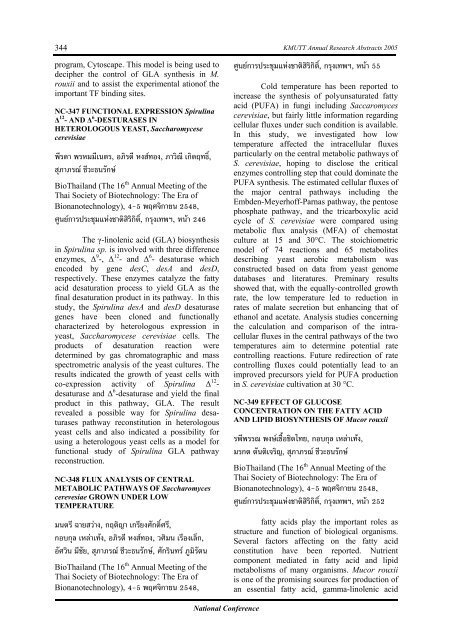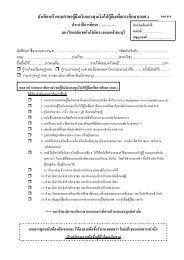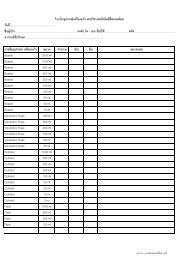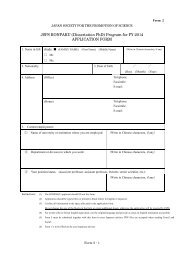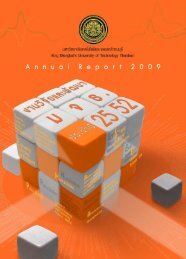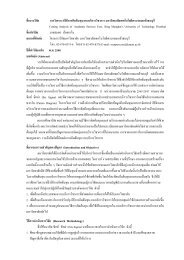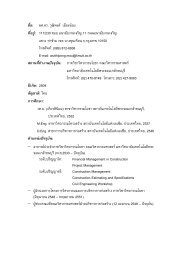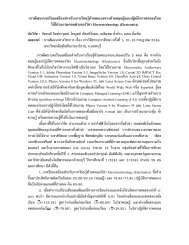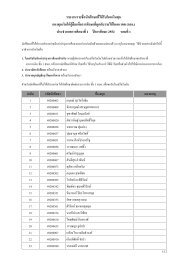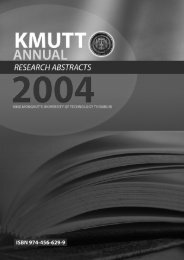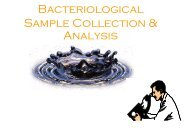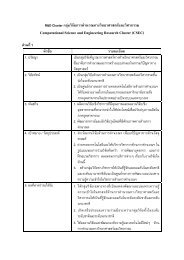Create successful ePaper yourself
Turn your PDF publications into a flip-book with our unique Google optimized e-Paper software.
344<br />
program, Cytoscape. This model is being used to<br />
decipher the control of GLA synthesis in M.<br />
rouxii and to assist the experimental ationof the<br />
important TF binding sites.<br />
NC-347 FUNCTIONAL EXPRESSION Spirulina<br />
∆ 12 - AND ∆ 6 -DESTURASES IN<br />
HETEROLOGOUS YEAST, Saccharomycese<br />
cerevisiae<br />
พีรดา พรหมมีเนตร, อภิรดี หงสทอง, ภาวิณี เกิดฤทธิ์,<br />
สุภาภรณ ชีวะธนรักษ<br />
BioThailand (The 16 th Annual Meeting of the<br />
Thai Society of Biotechnology: The Era of<br />
Bionanotechnology), 4-5 พฤศจิกายน 2548,<br />
ศูนยการประชุมแหงชาติสิริกิติ์, กรุงเทพฯ, หนา 246<br />
The γ-linolenic acid (GLA) biosynthesis<br />
in Spirulina sp. is involved with three difference<br />
enzymes, ∆ 9 -, ∆ 12 - and ∆ 6 - desaturase which<br />
encoded by gene desC, desA and desD,<br />
respectively. These enzymes catalyze the fatty<br />
acid desaturation process to yield GLA as the<br />
final desaturation product in its pathway. In this<br />
study, the Spirulina desA and desD desaturase<br />
genes have been cloned and functionally<br />
characterized by heterologous expression in<br />
yeast, Saccharomycese cerevisiae cells. The<br />
products of desaturation reaction were<br />
determined by gas chromatographic and mass<br />
spectrometric analysis of the yeast cultures. The<br />
results indicated the growth of yeast cells with<br />
co-expression activity of Spirulina ∆ 12 -<br />
desaturase and ∆ 6 -desaturase and yield the final<br />
product in this pathway, GLA. The result<br />
revealed a possible way for Spirulina desaturases<br />
pathway reconstitution in heterologous<br />
yeast cells and also indicated a possibility for<br />
using a heterologous yeast cells as a model for<br />
functional study of Spirulina GLA pathway<br />
reconstruction.<br />
NC-348 FLUX ANALYSIS OF CENTRAL<br />
METABOLIC PATHWAYS OF Saccharomyces<br />
cerevesiae GROWN UNDER LOW<br />
TEMPERATURE<br />
มนตรี ฉายสวาง, กฤติญา เกรียงศักดิ์ศรี,<br />
กอบกุล เหลาเทง, อภิรดี หงสทอง, วศิมน เรืองเล็ก,<br />
อัศวิน มีชัย, สุภาภรณ ชีวะธนรักษ, ศักรินทร ภูมิรัตน<br />
BioThailand (The 16 th Annual Meeting of the<br />
Thai Society of Biotechnology: The Era of<br />
Bionanotechnology), 4-5 พฤศจิกายน 2548,<br />
KMUTT Annual Research Abstracts 2005<br />
ศูนยการประชุมแหงชาติสิริกิติ์, กรุงเทพฯ, หนา 55<br />
Cold temperature has been reported to<br />
increase the synthesis of polyunsaturated fatty<br />
acid (PUFA) in fungi including Saccaromyces<br />
cerevisiae, but fairly little information regarding<br />
cellular fluxes under such condition is available.<br />
In this study, we investigated how low<br />
temperature affected the intracellular fluxes<br />
particularly on the central metabolic pathways of<br />
S. cerevisiae, hoping to disclose the critical<br />
enzymes controlling step that could dominate the<br />
PUFA synthesis. The estimated cellular fluxes of<br />
the major central pathways including the<br />
Embden-Meyerhoff-Parnas pathway, the pentose<br />
phosphate pathway, and the tricarboxylic acid<br />
cycle of S. cerevisiae were compared using<br />
metabolic flux analysis (MFA) of chemostat<br />
culture at 15 and 30°C. The stoichiometric<br />
model of 74 reactions and 65 metabolites<br />
describing yeast aerobic metabolism was<br />
constructed based on data from yeast genome<br />
databases and literatures. Preminary results<br />
showed that, with the equally-controlled growth<br />
rate, the low temperature led to reduction in<br />
rates of malate secretion but enhancing that of<br />
ethanol and acetate. Analysis studies concerning<br />
the calculation and comparison of the intracellular<br />
fluxes in the central pathways of the two<br />
temperatures aim to determine potential rate<br />
controlling reactions. Future redirection of rate<br />
controlling fluxes could potentially lead to an<br />
improved precursors yield for PUFA production<br />
in S. cerevisiae cultivation at 30 °C.<br />
NC-349 EFFECT OF GLUCOSE<br />
CONCENTRATION ON THE FATTY ACID<br />
AND LIPID BIOSYNTHESIS OF Mucor rouxii<br />
รพีพรรณ พงษเชื้อชิดไทย, กอบกุล เหลาเทง,<br />
มรกต ตันติเจริญ, สุภาภรณ ชีวะธนรักษ<br />
BioThailand (The 16 th Annual Meeting of the<br />
Thai Society of Biotechnology: The Era of<br />
Bionanotechnology), 4-5 พฤศจิกายน 2548,<br />
ศูนยการประชุมแหงชาติสิริกิติ์, กรุงเทพฯ, หนา 252<br />
fatty acids play the important roles as<br />
structure and function of biological organisms.<br />
Several factors affecting on the fatty acid<br />
constitution have been reported. Nutrient<br />
component mediated in fatty acid and lipid<br />
metabolisms of many organisms. Mucor rouxii<br />
is one of the promising sources for production of<br />
an essential fatty acid, gamma-linolenic acid<br />
National Conference


